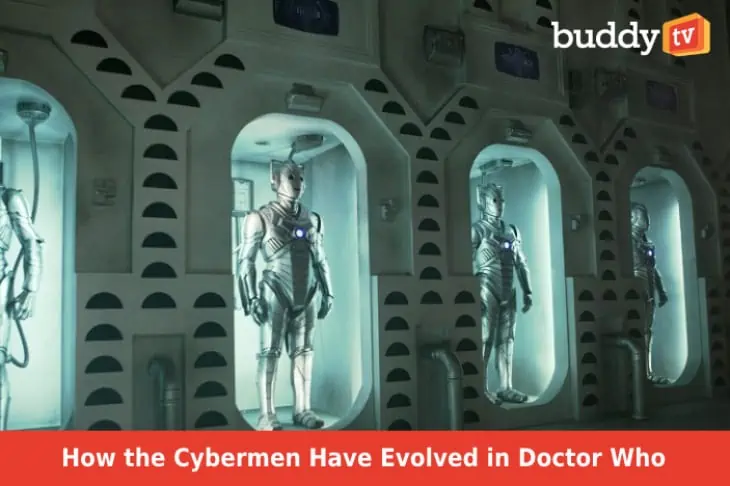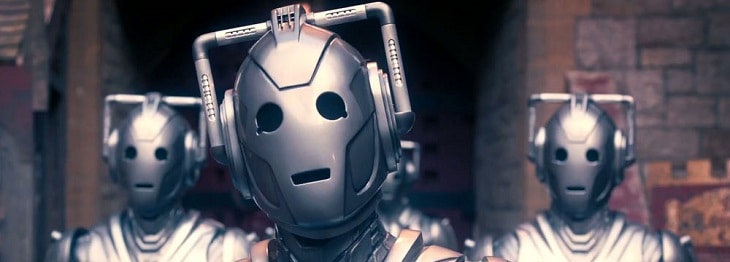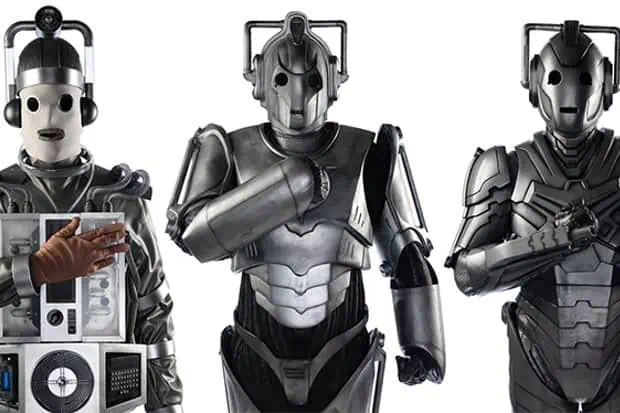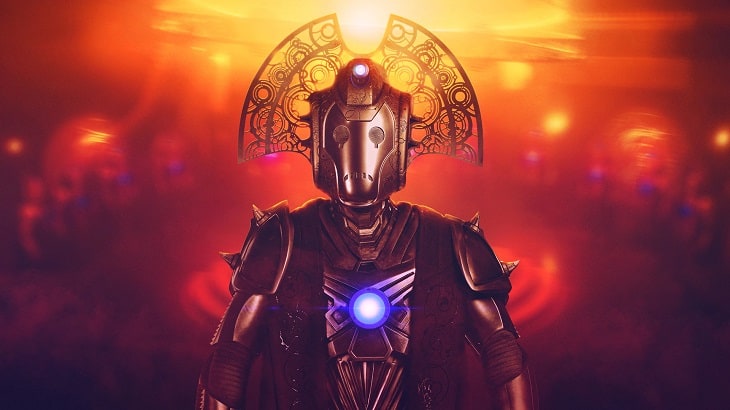The most recent Doctor Who 2022 Special aired a few days back, and despite its shortcomings, it brought together some of the Doctor’s best-known enemies — the Cybermen allied with the Daleks under the Master‘s directive to take down the Doctor and destroy the Earth.
In this article, we’ll discuss the aforementioned Cybermen and how they evolved in the Doctor Who series. So, without further ado, let’s get acquainted with less attractive and certainly less friendly versions of the Tin Man.
Who are the Cybermen?
Well, as their name implies, the Cybermen are a race — for the lack of a better term — of cybernetically augmented humanoids. They vary greatly in design due to numerous Cyber-subspecies from various locations across space-time evolving simultaneously.
They originally come from Earth’s twin planet, called Mondas, which drifted outside our solar system, and into the depths of space. The absence of the sun devastated and froze their planet. Those that remained, originally human beings, began experimenting with cyber enhancements to increase their survivability.
Thus early, original Mondasian cybermen were born. They had removed their human emotions through the process called cyber-conversion and soon came to believe themselves better than organic life forms. The first Cybermen soon embarked on a mission to convert all organic life into Cybermen, seize control of the galaxy, and spread the Cyber Empire across the stars, sparking Cyber wars in the process.
However, the Cybermen encountered another extraterrestrial anomaly during their intergalactic conquest. — one that would never accept defeat.
The Physical Characteristics of the Cybermen
Cybermen have really distinct features that make them easily recognizable; however, their design has changed significantly since the early days of the Doctor Who television show. Despite that, nearly all incarnations, regardless of the time and location within the universe, look really alike.
Additionally, many Cybermen also featured exposed wiring and tubing on their outer skin, which was made of rubber or mylar. However, some Cybermen had fully metal bodies with no exposed circuitry. While some Cybermen had skeletal Cyber-bodies, the Cybermen who attacked the Dreadnought had immensely muscular Cyber-bodies.
A Cyberman’s head is referred to as a Cyber-helmet, and it is frequently distinguished by a pair of side handles on the left and right sides of the helmet that joins above the helmet. There were eminent exceptions to this feature, though.
The CyberMondans had a third side handle that connected to their heads at the back. In order to “stop caring” about the severe pain they endured both during and after their cyber-conversions, the CyberMondans aboard the Mondasian colony ship employed their side handles as an emotional inhibitor.
These subsequent CyberMondans did not have side handles like the patients they evolved from. In contrast, some Cyber-Controllers had larger craniums rather than side grips. The Age of the Cyberiad was depicted by one Cyber-Controller as having a Cyberman wearing a Cyber-helmet without any side handles.
Some Cybermen have weapons hidden inside their Cyber-helmets. While the Cyber-helmets of CyberNomads had four gun barrels that fired rapid bullets, the CyberMondans could unleash orange, blazing lasers from the centerpiece of their side grips.
Other Cybermen Distinctions
There are also other notable differences; the CyberMondans of Mondas still had natural, human hands, while the CyberMondans of the Mondasian colony ship, on the other hand, wore white gloves.
Most other Cybermen were entirely covered by their metallic suits. Tobias Vaughn was one of the known partial conversions that still possessed human traits. Also, the Cybermen on the Moonbase and those that Eric Klieg freed on Telos were lean, emphasizing their emotionlessness, and spoke in a monotone, buzzing voice. The ArcHivist Hegelia recognized these Cybermen as CyberTelosians.
Deeper voices and larger, more intimidating shapes were characteristics of the Cybermen that attempted to destroy Earth in 2526. These Cybermen were what Hegelia called CyberNeomorphs. Similar Cybermen also existed in the 1980s, and Hegelia identified them as “CyberIsomorphs” after the time-traveling Neomorphs first appeared in 1985.
Early Mondasian Cybermen spoke in a quivering, sing-song manner with inflected syllables that appeared random. The face and hands of their costumes were not totally made of metal; rather, they were coated in a kind of toughened medical gauze.
Although they resembled Pete’s World’s Cybus Cybermen (the ones from the parallel universe) in appearance, the Cybermen in the Doctor’s world lacked the Cybus emblem on their chest. Two Cybus units were in a post-Cyber-Wars collection, indicating that the conflict had brought the two Cyber-species together.
The Cybermen possessed upgraded suits after the Cyber-Wars, presumably due to the hybridization between Pete’s World Cybermen and the Mondasian Cybermen. Their breast pieces on the new cyber-suits lit up blue. They were much more streamlined and compact than earlier variants. There was no wiring visible outside the suit.
The Cyber-Conversion
Cyber-conversion was the process through which physically similar and compatible humanoids were transformed into new Cybermen, allowing the alien race to multiply. Partial conversions, in which an individual wouldn’t be fully converted but would assume some Cybermen characteristics were also possible. Converting just human-like creatures was a huge drawback, but further development of the process allowed for them to convert corpses.
Cybermen Weaknesses
Despite eradicating the weaknesses of the flesh from their form, Cybermen have weaknesses of their own. Original Cybermen were severely allergic to gold, whose mere touch could prove fatal to them, as it primarily affected their respiratory systems.
However, early Cybermen used Cybus technology to eliminate more of their organic needs, such as the breathing system. Many Cybermen are vulnerable if their emotional inhibitor is damaged. The Thirteenth Doctor only assumed the post-Cyber-Wars Cybermen would be vulnerable to a neural inhibitor system, although feedback loops and damage to their neural inhibitor systems may damage their emotional inhibitor.
They were still mostly bulletproof, but UNIT developed a golden-tip ammo specifically designed for Cybermen. However, they were also still vulnerable to EMPs, or smaller electrical interferences.
Best Doctor Who Episodes Featuring Cybermen
Since their introduction early in the series, Cybermen have appeared over two dozen times. Here’s a small breakdown of some of the most iconic Doctor Who episodes featuring Cybermen:
The Tenth Planet — Ser2S4 — Classic Who
The Cybermen first appeared in The Tenth Planet episode, which sadly didn’t include their origin narrative. Mondas, the identical twin of Earth that is home to the Cybermen, had made its way back to our solar system when they made their debut.
Mondasian lifespans had decreased during their absence, so they created spare body parts until they could be nearly entirely replaced, giving rise to the Cybermen. As this was the adventure that introduced the regeneration and the Second Doctor — while also being the First Doctor’s last narrative.
Earthshock — Ser6S19 — Classic Who
The Cybermen from Mondas had only one clear option when an alliance of military powers to combat the Cybermen was being discussed on Earth: blow it up. When that fails, take control of a space freighter and destroy it by crashing it into the meeting. The Fifth Doctor did indeed beat the Cybermen, but this wasn’t a straightforward triumph. The TARDIS crew had to pay a terrible price…
Rise Of the Cybermen/The Age of Steel — E5/E6S2 — New Who
The Tenth Doctor finally had the chance to witness the process of cyber-conversion, which didn’t involve your typical Cybermen. Instead, he became caught up in a parallel universe’s development of the Cybermen. They had airships, so you could tell it was another Earth. These Cybermen started trampling their way across London after being created by John Lumic, the CEO of Cybus Industries. Thankfully, the Doctor had a strategy.
Army Of Ghosts/Doomsday — E12/E13S2 — New Who
The Cybus Cybermen appeared as spectral figures across our planet as they crossed the void between universes, appearing as if they had taken over the planet in one fell swoop. They had, however, pursued an unidentified sphere that they had not built through the emptiness.
We won’t offer any further spoilers, but the Tenth Doctor was appalled when he discovered who actually developed it. It’s also the first time Cybermen had a run-in with the Daleks.
Closing Time — E12S6 — New Who
The Mondas Cybermen made their first full-on appearance within the New Series in Closing Time, in which they made their long-awaited comeback.
The power source of a retail center woke up the Cyber-Ship crash survivors. After that, the Cybermen started to reassemble themselves using any spare parts they could locate and even started converting staff members into themselves. After noting the missing people and noticing power spikes in the region, The Eleventh Doctor discovered their existence.
Dark Water/Death in Heaven — E11/E2S8 — New Who
The Cybermen made another technical advancement during the Twelfth Doctor’s first encounter with them. They could now harvest the dead and resurrect them as Cybermen. The fact that Missy, the Master’s latest incarnation, appeared to be working with them only made matters worse. Her motivations for joining up with the Cybermen, however, completely caught the Doctor off guard. She wanted to offer him something.
The Haunting of Villa Diodati — E8S12 — New Who
The Doctor and her companions encountered the Lone Cyberman at Villa Diodati. The Lone Cyberman, whose true name is Ashad — pure nightmare fuel — was only partially transformed; his human visage was still partially visible. Ashad, who was partially human, detested all organic life and desired to bring the Cybermen back to their previous splendor. All he required to bring about that was? for the Doctor to hand up the Cyberium, an AI that held all of the Cybermen’s information.
Ascension Of the Cybermen/The Timeless Children — E9/E10S12 — New Who
Ashad embarked on his plan to restore the entire force of the Cybermen while traveling to the aftermath of the Cyber Wars. Little did Ashad realize that there was another power at work as Team TARDIS set out to stop him.
The Master was back and had his own views on how the Cyber race should develop. He gave them the option to become Time Lords in exchange for their capacity to regenerate. This gave birth to CyberMasters, which we saw in the recent Special.
How the Cybermen Have Evolved in Doctor Who
Cybermen have evolved significantly since their first appearance during the First Doctor’s era in 1966. Everything about them changed, including the cybermen costumes, which evolved along with with the show’s scenography, and the cyberman head, which now has a more robotic look to it.
Most important, however, is the evolution of their origin story. As stated above, the original Cybermen came from the tenth planet in our solar system. However, both Mondas and Mondasian Cybermen were destroyed following their run-i with the First Doctor.
The Cybermen’s origin was then retconned in Tomb of the Cybermen, which completely altered the Cybermen’s background. They were returned to the series due to their popularity during the Second Doctor era, creating the first contradiction within the series. And though Cybermen continued to appear in the show for years to come, their origins remained a point of contention among the fans.
The Sixth Doctor story called Attack of the Cybermen tried to reconcile the fandom by changing the backstory of the Cybermen once again. According to this version of events, the Cybermen originated on Mondas but had adopted the planet Telos as their home while restoring their birth world.
This origin story was officially canon until David Tennant’s Tenth Doctor arrived and tried to rectify the narrative once again. The new iteration of the Cybermen’s origins stated that the alien race came from outside the Doctor’s universe after they managed to invade Gallifrey. Since the entire history of Cybermen created a mess within the canon, Steven Moffat came up with the solution.
The newest version of their origin story, presented in The Doctor Falls, states that the Cybermen are a product of parallel evolution and an inevitable development wherever there’s life, regardless of the planet or universe they come across. But it also gives us something for the future.
What More Can We Speculate about the Cybermen in the Future?
Well, we can’t speculate much, unfortunately. The Cybermen, despite being among the Doctor’s oldest foes chronologically, never actually attained the Master’s level of maliciousness, which could be juxtaposed against the courage and selflessness of the Doctor.
As such, they’ll always remain a story device rather than an actual opponent for the Time Lord. However, that could change. Moffet’s introduction of Cybermen as the evolutionary step of life, regardless of how aggressively anti-life it may seem, encapsulates all the previous origin stories into one.
Interestingly, it also opens the door to any potential future origin stories and sub-species of Cybermen to co-exist within the same universe with the Cybermen we previously met.
Doctor Who Cybermen Quiz
Which Version of the Doctor Never Encountered Cyberman at All From the Original Era?
In "Nightmare in Silver," What is the Name that the Cyberiad Gave Itself When Possessing One Half of the Doctor's Consciousness?
Where Does the Doctor Encounter His Very First Cyberman?
Why Were the Cybermen Historically Allergic to Gold?
In 'Tomb of the Cybermen' What Cyber "Pet" Makes It's First Ever Introduction?

Contributing Writer, BuddyTV
Jason Collins is a freelance Pop Culture Journalist with a degree in English Literature. While he has had the distinct privilege of seeing Tom Baker up close he was not offered any Jelly Babies which was highly disappointing. When he’s not out on the hunt for the latest and greatest podcast he is lounging at home with more cats than he would care to disclose at this temporal moment.







![10 Best Movies About Jesus Christ [Ranked by Viewers]](https://www.buddytv.com/wp-content/uploads/2022/10/movies-about-jesus-christ.jpg)
![Tomb Raider Movies In Order [How to Watch]](https://www.buddytv.com/wp-content/uploads/2022/10/Tomb-Raider-Movies-In-Order.jpg)